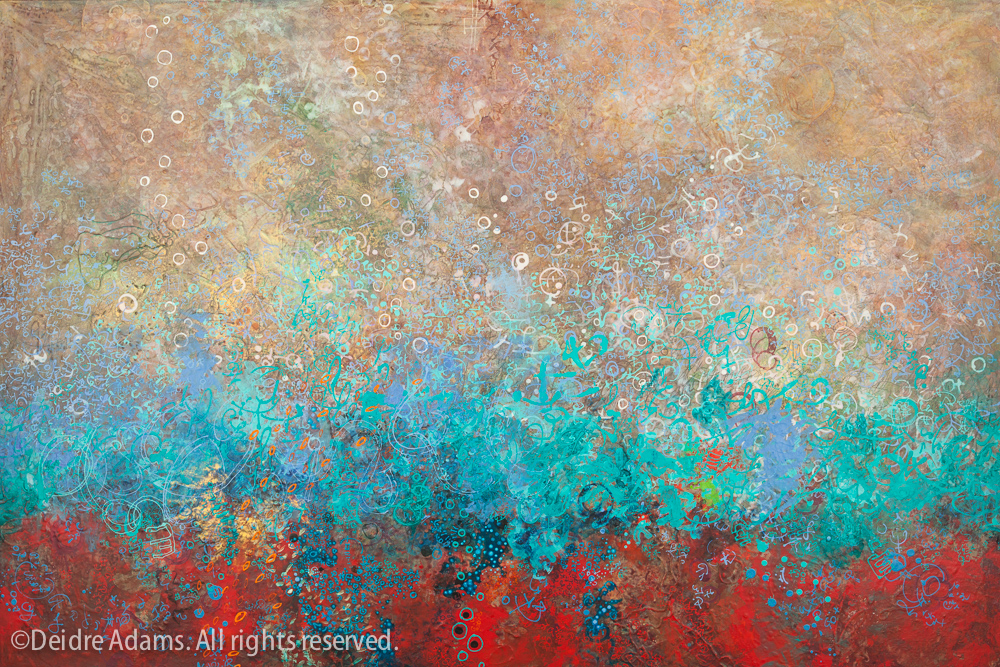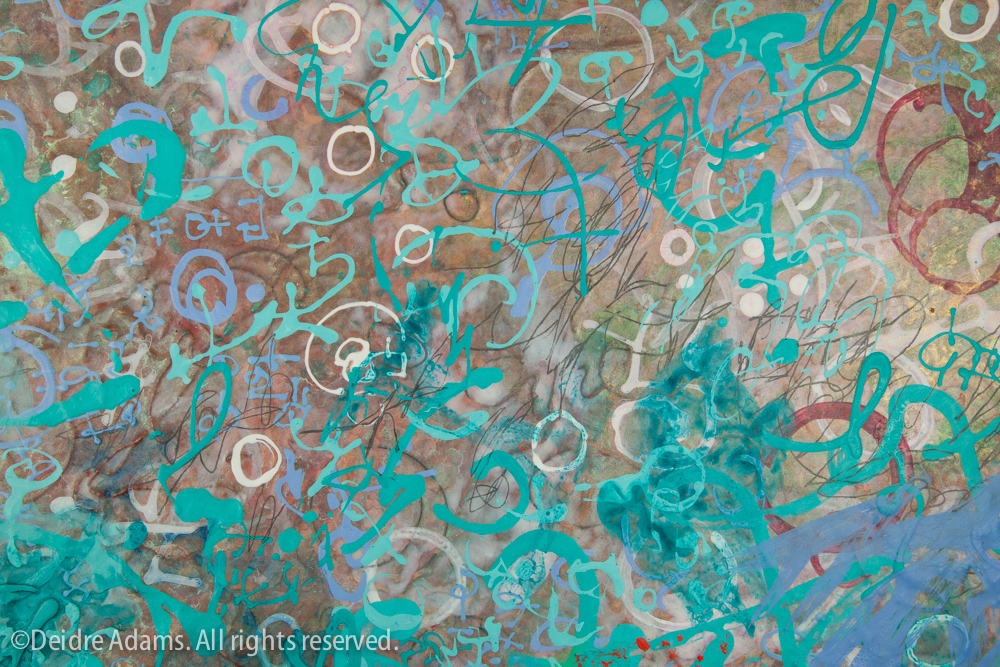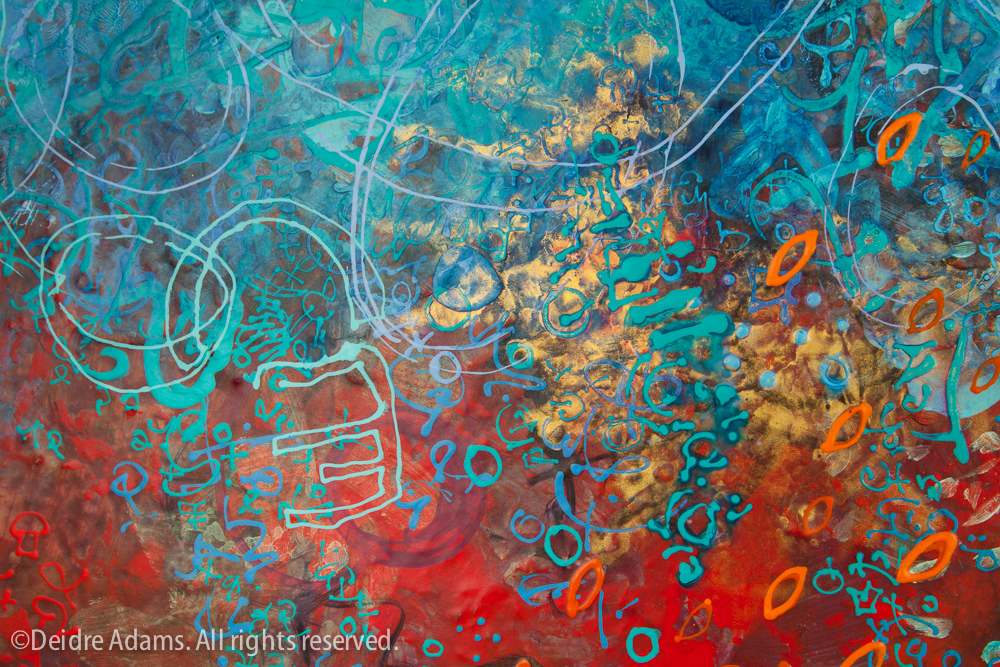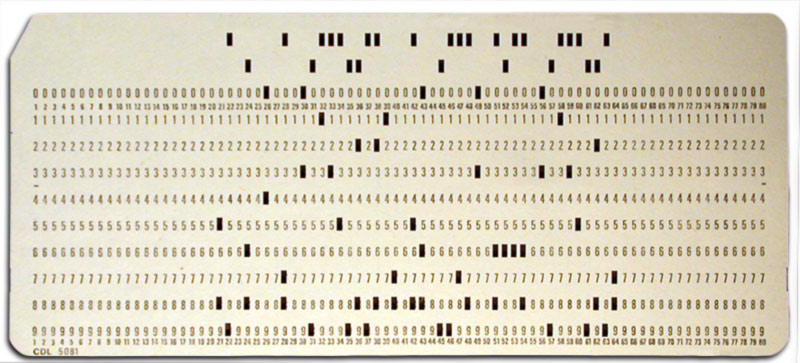 Pseudocode, 42 x 78 inches, acrylic & mixed media on panel, ©2014 Deidre Adams
Pseudocode, 42 x 78 inches, acrylic & mixed media on panel, ©2014 Deidre Adams
A long, long, time ago — in what feels like an entirely different lifetime — I went to a technical/vocational school in Albuquerque and enrolled in a course of study called Data Processing. The field wasn’t as complicated back then, so this prosaic name was perfectly acceptable. I’m going to really be dating myself here, but the first computer language I learned was COBOL (COmmon Business Oriented Language). Before the school upgraded to their snazzy new Data General with input terminals in the early 1980s, we had to type our program code onto punch cards. Really, kids!
One mistake in typing, and you had to throw the whole card out and start over. Some of the programs got to be pretty long, with several hundred cards that absolutely had to remain in the right order. Having your program run involved handing your box of cards to a lab tech and then coming back hours later to get back your cards along with a printout of the results. Because you never got it right the first time, you’d then have to debug and type some new cards with the changes. This was an iterative process which could involve many rounds. If your program got to the point of being many inches worth of cards, the lab techs had a great joke they might play on you, especially if they knew your deadline was imminent. They would come out with your box, with the cards all piled up in a big jumble and say, “I’m so sorry — I tripped!” After several minutes of enjoying your utterly panic-stricken (or rage-filled) response, they would reveal that your stack was safe and sound the whole time and it was all just fun and games.
Prior to doing the real coding, a programmer would first write out the program in pseudocode, a kind of higher-level outline that would help to organize the logic of the program before getting too far into the weeds of code. I hadn’t thought about this in years, but last summer I went through a basement purging and found some old COBOL textbooks that I had held onto all this time for who knows what reason.
We had pre-printed forms for writing pseudocode.
 From Introduction to Computer Programming: Structured COBOL, Shelly & Cashman, 1978.
From Introduction to Computer Programming: Structured COBOL, Shelly & Cashman, 1978.
The next step was to translate the pseudocode into code, written by hand onto yet another form. So primitive!
 From Introduction to Computer Programming: Structured COBOL, Shelly & Cashman, 1978.
From Introduction to Computer Programming: Structured COBOL, Shelly & Cashman, 1978.
But I digress.
This got me to thinking about the word pseudocode, and how it’s rather a good metaphor for the kind of communication that’s prevalent in the media now — a lot of coded language, sounding like it means something, but quite often saying little to nothing that’s going to make a difference in people’s lives. This also ties back into my work, in which I use expressive gestures and calligraphic symbols which have a kind of significance for me but don’t convey any concrete meaning to the viewer.
 Pseudocode (detail), acrylic & mixed media on panel, ©2014 Deidre Adams
Pseudocode (detail), acrylic & mixed media on panel, ©2014 Deidre Adams
 Pseudocode (detail), acrylic & mixed media on panel, ©2014 Deidre Adams
Pseudocode (detail), acrylic & mixed media on panel, ©2014 Deidre Adams
All this is fodder going towards me re-thinking my artist’s statement in preparation for the upcoming show. I think every artist should do this from time to time, and what better time than when you have an opportunity to show some new work? I hope to have an updated statement ready to post very soon.


Oh my gosh, COBOL and DG terminals! I bypassed punch cards but you’ve brought back a lot of memories. Love this painting!
I remember Cobol, I worked for a typesetting firm and we input to a data general which spewed out paper tapes. We used to save bags of the chads for some odd reason. I proofed so much on screen that I learned the code by osmosis and could correct the typesetting mistakes on my own. I was a graphic designer. Boy was I glad when Macs came in and I could do my own design!
How about using gel medium to glue the code cards down and painting over them? (Or you could send them to me and I’ll do it!)